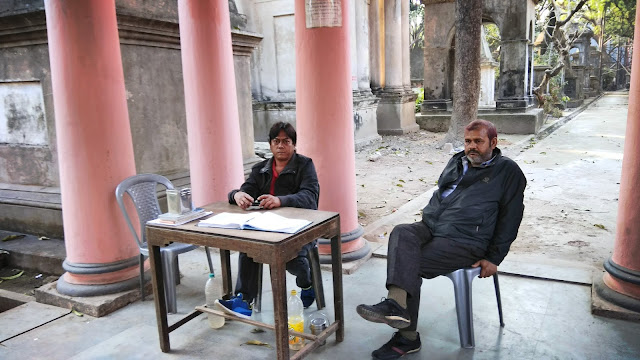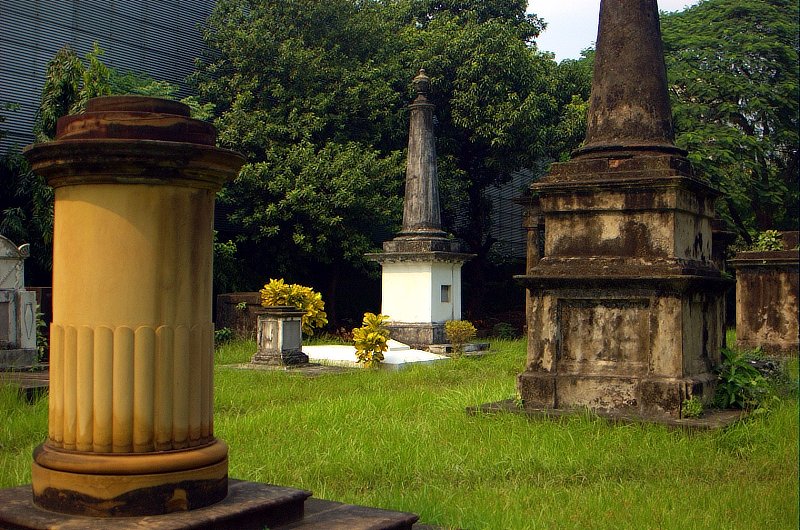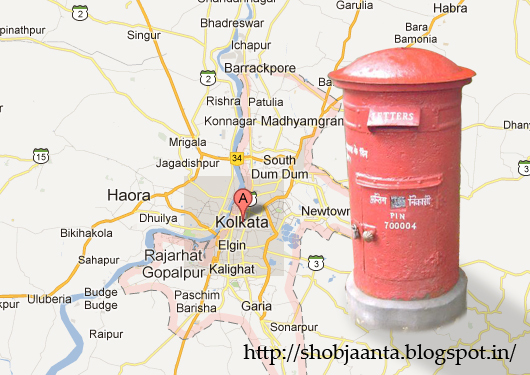Park Street Cemetery - Reminiscence of the British Raj
During the British Raj there were some good things also that happened... especially in the field of art and architecture. A new architectural style movement was started by the British architects in the late 19th century with the help of Indian artisans and was called the "Indo-Saracenic Revival", also known as Indo-Gothic, Mughal-Gothic and Neo-Mughal architectural style. Since Biritishers had most of their establishments in the port cities of Calcutta (now Kolkata) and Bombay (now Mumbai) so we get to see so many beautiful Buildings and monuments.
One such place in Kolkata is The South Park Street Cemetery (SPSC). The whole area, measures some eight acres, and is enclosed by a high brick wall. There are almost 1600 tombs with cenotaphs, tablets, mausoleums and epitaphs. These graves are surrounded by tall, shady trees, bushes and plants of many varieties.
The South Park Street Cemetery was one of the earliest non-church cemeteries in the world. It is also referred as the largest Christian cemetery outside Europe and America in the 19th century.
The place is very much near the Park Street (Mother Teresa Sarani) and AJC Bose Road (Lower Circular Road) crossing that is called the "Mullick Bazaar" crossing. Nearest railway station is Sealdah and the Nearest Metro Rail station is Park Street. The place is just opposite "The Assembly of God Church".
A nominal entry fee of Rs.10 is charged and if you want to take photos then you need to buy a Camera Permission Ticket too for Rs. 50/-
The South Park Street Cemetery was built in 1767 for the earliest British pioneers of the East India Company and was used actively until the 1830s. If we go through the Tomb Stones of the graves then we see that many of the people burried here died very young... May be they were unable to adjust with the hot and humid weather of Bengal compared to the one they had, back home in England.
Many of the Tombs are endangered by the roots of the adjoining trees and we do see such notices being placed on those graves. Even tourists harm these tombs. I saw people have inscribed their names on these graves.
Some of the graves are being repaired and restored by the Asiatic Society of India, which is also nearby on the other end of the Park street. Few graves are being restored by the family members and descendants of the ones buried underneath.
The cemetery still houses the remains of the colonial elite-bureaucrats, military officials, the mercantile big shots and their families from the British Raj era.
The cemetery also houses a small nursery that takes care of the trees, plants, flowers and the overall ecosystem of the place.
To get an index of burials recorded in BACSA`s (British Association for Cemeteries) Cemetery Record Books relating to India and Burma in South Asia one can visit the following link:- https://goo.gl/S8LAf6
Also there's a website to search and update Grave records: https://www.findagrave.com/
Famous People Buried in South Park Street Cemetery:
1) Henry Louis Vivan Derozio
Teacher, Poet and Patriot... Mentor of young Bengal... Pioneer of the 18th century Indian Renaissance...
The grave is being maintained by "The All India Anglo Indian Association"
Age: Died at 22 (1809-1831)
Birthplace: Kolkata, India
2) Sir William Jones
He was an Anglo-Welsh philologist and scholar of ancient India, particularly known for his proposition of the existence of a relationship among Indo-European languages. He, along with Henry Thomas Colebrooke and Nathaniel Halhed, founded the Asiatic Society of Bengal,
Age: Died at 48 (1746-1794)
Birthplace: London, United Kingdom
3) Colonel Robert Kyd
He was a British army officer stationed in India. He founded the botanical garden at Calcutta in 1787.
Age: Died at 47 (1746-1793)
Birthplace: Forfarshire
4) Charles Stuart
Major-General Charles Stuart was an officer in the East India Company Army and is well known for being one of the few British officers to embrace Hindu culture while stationed there, earning the nickname Hindoo Stuart. His tomb has a hindu temple type "Panchyatana" Architecture style.
Age: Died at 70 (1758-1828)
Birthplace: Kingdom of Ireland
5) Augustus Cleveland
He was an East India Company administrator. Cleveland is said to have been a cousin of John Shore, 1st Baron Teignmouth and governor-general of India, and seems to have been an Indian administrator of exceptional ability and shrewdness. He was collector and magistrate of Bhagalpur.
Age: Died at 30 (1754-1784)
6) John Clavering
Lieutenant General Sir John Clavering KB was an army officer and diplomat.
Age: Died at 55 (1722-1777)
Birthplace: Northumberland, United Kingdom
7) Walter Landor Dickens
son of English novelist Charles Dickens. He was buried initially in Bhowanipore war cemetery and the tombstone was later moved here in 1987
Age: Died at 22 (1841- 1863)
The address of The South Park Street Cemetery is:
52, Park Street, Near Mullick Bazaar, Kolkata 700016
Website:http://www.christianburialboardkolkata.com
Timings: 10AM to 5PM, Everyday open
Phone: 033 2286 7104
No. of graves: 1600 graves or tombs.
Nearest Metro Station: Park Street
Nearest Bus Stop: Mullick Bazaar
Some more information:
 |
| Park Street Cemetery Source |
One such place in Kolkata is The South Park Street Cemetery (SPSC). The whole area, measures some eight acres, and is enclosed by a high brick wall. There are almost 1600 tombs with cenotaphs, tablets, mausoleums and epitaphs. These graves are surrounded by tall, shady trees, bushes and plants of many varieties.
 |
| Main Gate of South Park Street Cemetery Source |
 |
| The ticket counter |
The place is very much near the Park Street (Mother Teresa Sarani) and AJC Bose Road (Lower Circular Road) crossing that is called the "Mullick Bazaar" crossing. Nearest railway station is Sealdah and the Nearest Metro Rail station is Park Street. The place is just opposite "The Assembly of God Church".
 |
| Tomb of Major-General Charles Stuart aka Hindoo Stuart |
 |
| Pathways inside the Cemetery Source |
 | |
|
 |
| Inside the Cemetery Source |
 |
| A Dilapidated Tombstone |
 |
| Lush Green Grasses inside the Cemetery Source |
 |
Also there's a website to search and update Grave records: https://www.findagrave.com/
Famous People Buried in South Park Street Cemetery:
 |
| Grave of Henry Louis Vivan Derozio |
Teacher, Poet and Patriot... Mentor of young Bengal... Pioneer of the 18th century Indian Renaissance...
The grave is being maintained by "The All India Anglo Indian Association"
Age: Died at 22 (1809-1831)
Birthplace: Kolkata, India
2) Sir William Jones
He was an Anglo-Welsh philologist and scholar of ancient India, particularly known for his proposition of the existence of a relationship among Indo-European languages. He, along with Henry Thomas Colebrooke and Nathaniel Halhed, founded the Asiatic Society of Bengal,
Age: Died at 48 (1746-1794)
Birthplace: London, United Kingdom
3) Colonel Robert Kyd
He was a British army officer stationed in India. He founded the botanical garden at Calcutta in 1787.
Age: Died at 47 (1746-1793)
Birthplace: Forfarshire
4) Charles Stuart
Major-General Charles Stuart was an officer in the East India Company Army and is well known for being one of the few British officers to embrace Hindu culture while stationed there, earning the nickname Hindoo Stuart. His tomb has a hindu temple type "Panchyatana" Architecture style.
Age: Died at 70 (1758-1828)
Birthplace: Kingdom of Ireland
5) Augustus Cleveland
He was an East India Company administrator. Cleveland is said to have been a cousin of John Shore, 1st Baron Teignmouth and governor-general of India, and seems to have been an Indian administrator of exceptional ability and shrewdness. He was collector and magistrate of Bhagalpur.
Age: Died at 30 (1754-1784)
6) John Clavering
Lieutenant General Sir John Clavering KB was an army officer and diplomat.
Age: Died at 55 (1722-1777)
Birthplace: Northumberland, United Kingdom
7) Walter Landor Dickens
son of English novelist Charles Dickens. He was buried initially in Bhowanipore war cemetery and the tombstone was later moved here in 1987
Age: Died at 22 (1841- 1863)
 |
| A tomb That's a Perfect Example of Ancient Roman architecture |
The address of The South Park Street Cemetery is:
52, Park Street, Near Mullick Bazaar, Kolkata 700016
Website:http://www.christianburialboardkolkata.com
Timings: 10AM to 5PM, Everyday open
Phone: 033 2286 7104
No. of graves: 1600 graves or tombs.
Nearest Metro Station: Park Street
Nearest Bus Stop: Mullick Bazaar
Some more information:








Comments
Post a Comment
Please feel free to comment on this post